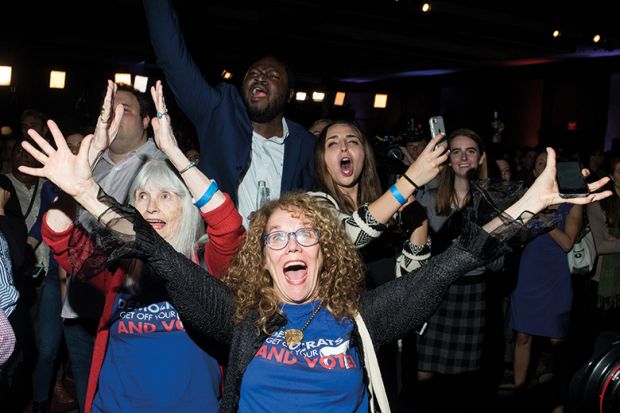Universities hoping for imminent legislative solutions to funding shortfalls and the student debt crisis after the Democrats seized control of the US House of Representatives may be left disappointed, according to the sector’s main lobby association.
Terry Hartle, senior vice-president for government and public affairs at the American Council on Education, said that the partisan divide in Washington was only likely to deepen in the wake of the midterm elections, leaving federal lawmakers increasingly incapable of solving the gnarly challenges awaiting them.
Although the Democrats, a party increasingly associated with higher education, now holds the House, the Senate remains under Republican control.
“The new Congress will find it even harder than the current Congress to pass complicated multifaceted legislation, no matter how much it might be needed,” Mr Hartle predicted.
There is more optimism at the state level. At least a half-dozen governors elected in the midterms promised to make university tuition fee-free or debt-free, at least for needier students. Several others pledged to reverse previous cuts in higher education spending by Republican predecessors, while others talked of helping students control costs by consolidating their authority over their public colleges.
The most cathartic win may have been in Wisconsin, where Democrat Tony Evers narrowly defeated the incumbent governor, Scott Walker. Mr Walker gained national attention for defiantly eliminating collective bargaining for public employees, and then proceeded to slash the state university’s budget and attack tenure rights.
Voters in more than a dozen states also backed hundreds of millions of dollars in tax increases and new borrowing authority to help students pay their tuition costs and colleges build facilities.
Such successes were aided by a long-awaited expansion in voting by people of college age. Tufts University researchers estimated that 31 per cent of Americans aged 18 to 29 voted Tuesday, well above the 21 per cent in the previous midterm election in 2014, yet still well below the 49 per cent of all eligible voters who participated.
The Democratic success also was aided by the dozens of higher education professionals and academics who stood as candidates. Most lost, but three of them captured House seats previously held by Republicans.
Against the backdrop of a divided Congress, the job of restoring US higher education to financial health remains formidable.
In a reversal of a decades-old approach, US public colleges and universities now must rely on tuition-fee dollars more than government support. The rate of colleges failing is understood to be accelerating. Internet-based efficiencies seem promising, but institutions are uncertain about best practices and are wary of the tawdry reputation generated by unscrupulous for-profit competitors.
That is where action by Congress is most needed right now, Mr Hartle said. The federal government currently uses traditional measures of academic delivery and performance – such as credit hours and time spent with faculty – to judge whether a college should be eligible for its students to receive federally subsidised loans and grants.
Those older-style measures need to be changed to reflect the ways that online models function, Mr Hartle said. The Trump administration plans early next year to begin a formal review of regulatory changes that would encourage those models. But any regulatory changes cannot exceed the limits of existing laws, and for many needed changes, the underlying laws need revision, Mr Hartle said.
“You obviously want to allow high-quality new providers some access to federal student aid,” Mr Hartle said. “But you want to keep the crooks away from the money, and that’s a delicate balancing act, and it needs to be done with a great deal of care.”
Changes also are necessary in the structure of federal student loan and grant systems, Mr Hartle said. Congress sets the level of student aid spending each year, but the statutory language needs regular updates to best direct that aid to the students and programmes that are most deserving, he said.
But Congress appears to have become even less capable of finding measured balance, Mr Hartle said. While Democrats won many races in the midterms, he said that many of the Republican losses were among their more moderate members – forced out by an electorate increasingly unwilling to see compromise as a virtue.
That attitude, reflected in the administration’s harsh tone towards many immigrant groups, may also be hurting US universities by driving away foreign students – who often pay full tuition fees and bring valuable outside perspectives – and jeopardising scientific collaborations.
US universities are fearful of their country appearing “less welcoming as a destination for the world’s best students and scholars,” Mr Hartle said.
Register to continue
Why register?
- Registration is free and only takes a moment
- Once registered, you can read 3 articles a month
- Sign up for our newsletter
Subscribe
Or subscribe for unlimited access to:
- Unlimited access to news, views, insights & reviews
- Digital editions
- Digital access to THE’s university and college rankings analysis
Already registered or a current subscriber? Login







